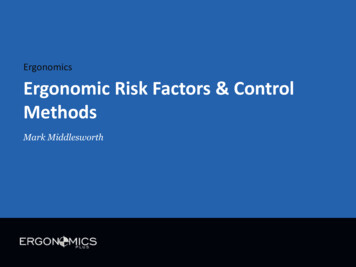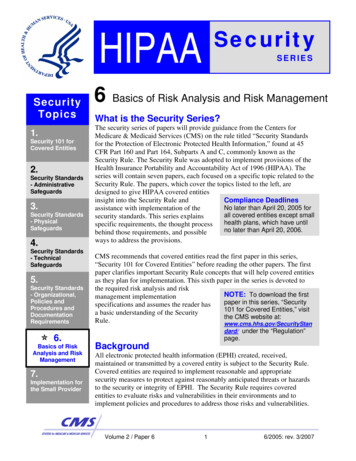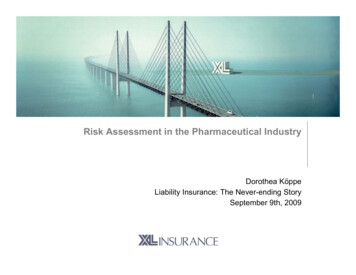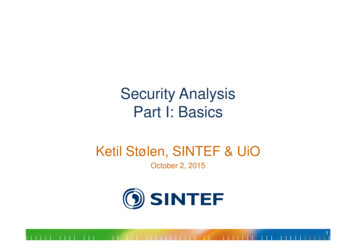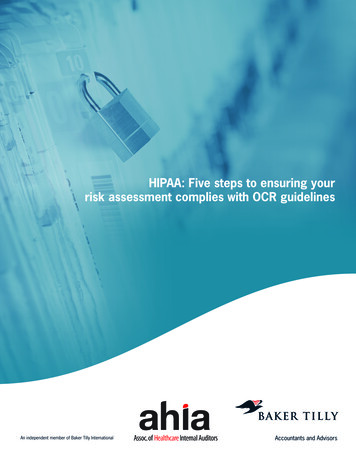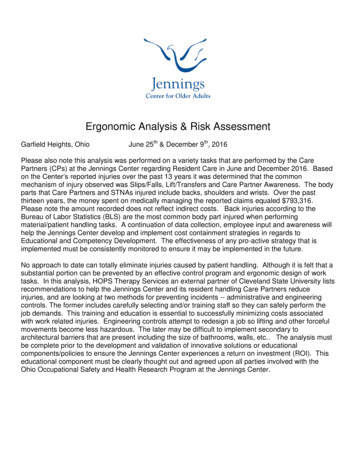
Transcription
Ergonomic Analysis & Risk AssessmentGarfield Heights, OhioJune 25th & December 9th, 2016Please also note this analysis was performed on a variety tasks that are performed by the CarePartners (CPs) at the Jennings Center regarding Resident Care in June and December 2016. Basedon the Center’s reported injuries over the past 13 years it was determined that the commonmechanism of injury observed was Slips/Falls, Lift/Transfers and Care Partner Awareness. The bodyparts that Care Partners and STNAs injured include backs, shoulders and wrists. Over the pastthirteen years, the money spent on medically managing the reported claims equaled 793,316.Please note the amount recorded does not reflect indirect costs. Back injuries according to theBureau of Labor Statistics (BLS) are the most common body part injured when performingmaterial/patient handling tasks. A continuation of data collection, employee input and awareness willhelp the Jennings Center develop and implement cost containment strategies in regards toEducational and Competency Development. The effectiveness of any pro-active strategy that isimplemented must be consistently monitored to ensure it may be implemented in the future.No approach to date can totally eliminate injuries caused by patient handling. Although it is felt that asubstantial portion can be prevented by an effective control program and ergonomic design of worktasks. In this analysis, HOPS Therapy Services an external partner of Cleveland State University listsrecommendations to help the Jennings Center and its resident handling Care Partners reduceinjuries, and are looking at two methods for preventing incidents -- administrative and engineeringcontrols. The former includes carefully selecting and/or training staff so they can safely perform thejob demands. This training and education is essential to successfully minimizing costs associatedwith work related injuries. Engineering controls attempt to redesign a job so lifting and other forcefulmovements become less hazardous. The later may be difficult to implement secondary toarchitectural barriers that are present including the size of bathrooms, walls, etc. The analysis mustbe complete prior to the development and validation of innovative solutions or educationalcomponents/policies to ensure the Jennings Center experiences a return on investment (ROI). Thiseducational component must be clearly thought out and agreed upon all parties involved with theOhio Occupational Safety and Health Research Program at the Jennings Center.
It is obvious that Care Partners can suffer from two types of injuries including Cumulative Trauma Disorders(CTD) and Musculoskeletal Disorders (MSD). CTDs are injuries that occur with repeated stressful exposuresto the body and MSDs occur because of a single traumatic event. Care Partners that participate in tasks thatinherently have higher number of common risk factors are more vulnerable to either injury classification. They may have poor physical conditioning secondary to limited exposure to the type of workthroughout the year. Some employees may also lack the physical capacities to perform the work from the start, however,were utilized versus looking at the impact to the CP or the Jennings Center. Also please note that every person may react differently to common risk factors and drivers that havemore “predisposing factors” including arthritis, obesity and poor physical conditioning may be moresensitive to injuries than others.COMMON RISK FACTORSPrimary occupational risk factors for MSDs discussed in this report include the following.The average number of movements or exertions performed by a joint or a bodyRepetition:link within a unit of time. Repeated identical or similar motions performed over aperiod of time could cause over-extension and overuse of certain muscle groups,which could lead to muscular fatigue or injury.Force is the mechanical or physical effort to accomplish a specific movement TemperatureExtrinsic Stress(Work Pace)Defined as impingement or injury by hard, sharp objects, equipment orinstruments when grasping, balancing or manipulating. Care Partners stressesare encountered when working with forearms or wrists against the edge of a bedor bath tub. The muscles and tendons are impinged when pressed into the sharpedge.Awkward postures refer to positions of the body (limbs, joints, back) that deviatesignificantly from the neutral position while job tasks are being performed.Awkward postures often are significant contributors to MSDs because theyincrease the work and the muscle force that is required.Vibration has been found to be an etiological factor in work environments utilizingtools that vibrate. Powered instruments that operate at a higher frequency andhaving a greater duration of exposure to vibratory forces can be harmful.Excessive vibration causes pain to muscles, joints and internal organs; causesnausea and trauma to the hands, arms, feet and legs. Vibration is measured byits direction, acceleration and frequency on the bodyLow temperatures reduce manual dexterity and accentuate the symptoms ofnerve-end impairment.Extrinsic stress, or sometimes called organizational factors, can be defined asthe way in which work is structured, supervised and processed. Extrinsic stressreflects the objective nature of the work process. It may include such variables asjob variety, job control, workload, time pressure, and financial constraints. In theNursing Assistant Industry it can be the time pressure, financial constraints,workload and job control which all can contribute to a higher incidence of MSDs.Some information contained within this fact sheet was extracted in part from the National Institute for Occupational Safety and Health (NIOSH) and The United StatesDepartment of Labor, Occupational Safety and Health AdministrationMethodology
To simplify the evaluation of the position, the Care Partners highest risk tasks have been identified interms of resident handling, work environment setup and solutions for the individual tasks. In addition,there remains to be fundamental issues that were identified as safety concerns in terms of slips, tripsand falls, as well as the body positioning errors in terms of Care Partner body mechanics.PHYSICAL DEMAND CLASSIFICATIONS(U.S. DEPT OF LABOR) – Dictionary of Occupational Titles – O’Net MediumMedium-HeavyHeavyVery Heavy10 lbs.20 lbs.35 lbs.50 lbs.75 lbs.100 lbs.Over 100 lbs.FrequentNegligible10 lbs.15 lbs.25 lbs.35 lbs.50 lbs.Over 50 lbs.ConstantNegligibleNegligible7 lbs.10 lbs.15 lbs.20 lbs.Over 20 lbs.The evaluation targeted certain essential functions in order to quantify the number of common riskfactors and risk associated with a job task. The higher the number of risk factors identified, thegreater the chance for injury. The Care Partner’s position at the Jennings Center is classified ashaving a Medium-Heavy Strength Range requirement. The physical requirements span across 3categories secondary to the inconsistent environments that the Care Partners are exposed to on thejob. For instance, often residents take baths/showers that increase the risk for multiple reasons (i.e.coupling technique with wet body, wet floors, etc.).Analysis:Job Task Lifting Residents for BathPerformanceSolution Employee should ensureharness is overlapping intofigure 8 position. The figure 8position may need to be alteredfor peri area cleaning/washingand other wound tasks. Jennings Center MaintenanceDepartment should removearchitectural barriers to allowresident’s lower extremities toclear the tub side.Employees utilize theceiling lift and harness totransfer residents intobathtubs.
Employees lift resident’slower extremities utilizethe ceiling lift and harnessto transfer residents intobathtubs.Postures: Standing,forward bending, walking,lifting waist level,reaching, pushing/pulling,forceful gripping andhandling.Material Handled:Adjusting resident bypushing forward andslipping harness underresident. Forces requiredvary depending onresident abilities. Jennings Center MaintenanceDepartment shouldremove/replace architecturalbarriers including toilet paperholders that are obstructing thegrab bar or are causing bumpsto resident’s head whiletransferring to toilet. Care Partner utilizes lift to fullcapacity to elevate residentover sidewall of bathtub. Avoidflexing spine to lift lowerextremities of edge of tub.Avoid flexing spineCommon Risk Factors Awkward PosturesWork paceCompressionForceRepetition
Analysis cont Job Task Resident Care Bedside Dressing/Wound Care/WashingPerformanceCare Partners performmany resident care needswhile leaning over bedsincluding lower extremitydressing, woundmanagement and bathingtasks.CPs often must manuallylift large lower extremitiesin an awkward postureincreasing spinalcompression placing theirbacks into poor positionsand risking injury.Solution Large dependent legs can bevery heavy and awkward to lift.Liko patient handling slings canbe purchased and utilized toassist with lower extremitybathing, dressing and woundcare. Slings are fastened tooverhead lifts and used toadjust extremities heightcorresponding to CP’s comfort. Variety of slings should beutilized in order to assist withbathing and personal hygiene.Postures: Standing,forward bending, kneeling,walking, climbing, floor tooverhead reaching andlifting, forcefulpushing/pulling, forcefulgripping, pinching andhandling.Material Handled: Weightand forces required wouldvary depending on patientcomorbidities.Common Risk Factors Work PaceAwkward PosturesForceRepetition
Analysis cont Job Task Care Partners assist withresident transfers to and frombedroom toilets. Resident’smobility status is evaluatedand determined prior toperforming any toilettransfers.CPs must reach over theback of wheelchair whichdoes not allow enough roomfor her knees to perform aproper squat and lift. Postures: Standing, forwardbending, kneeling, walking,climbing, floor to overheadreaching and lifting, forcefulpushing/pulling, forcefulgripping, pinching andhandling. Material Handled: Weightand forces required wouldvary depending on patientcomorbidities. Limited space in bathroom toface resident and properlyperform a stand and pivottransfer.Bed Mobility and TransfersPerformanceSolution Residents should be evaluatedby a Physical Therapist todetermine and clearly marktransfer status on dry eraseboard.Resident rooms should haveassigned gait belts. Transfers totoilet should incorporate gait beltand assistive device.Wheelchairs should be parkedby sink limiting trip hazards. The small space in the bathroomplaces the CPs in a poorposition when assistingresident’s to the toilet. It isessential that resident’stransferring to their bedroomtoilets are a Minimum, Standby/Contact Guard Assist orIndependent functional mobility. Sit and Stand Lifts to assist withstand and pivot toilet transfers.
Employees re-positionresidents to the head of bedto ensure proper positioningof residents.Heights of Care Partnersvary which places the talleremployee at more of adisadvantage. Common Risk Factors RepetitionForce applied variesCompressionAwkward Postures (whole body)Extrinsic Stress (time pressure, workpace, workload, etc )*** High number of risk factors increasesvulnerability to MSD.Jennings Center acquiresadditional re-positioning slings toeliminate common risk factors.
Summary of Recommendations1. Pre and Post Discomfort SurveyThe implementation of annual discomfort surveys can identifytrends and issues related to the work environment. Surveys aredispersed at the Fall Frenzy and are completed every year.Meeting with high risk/scored CPs is essential to implementproactive strategies in order to keep MSD/CTDs under control.2. Body Mechanics and Common MSDAll STNA/CPs on the account should be trained preferably during/afterthe pre-work screen on the risk associated with lifting boxes in twistedand awkward positions. This training should encourage STNAs to adoptproper body mechanics to perform lifts and their daily work tasks.STNAs should also note that injuries are more likely to occur becauseof forceful pulling versus pushing. This body mechanics training mustconsider the work environment for the drivers, and not focus on liftingmechanics associated with optimal work conditions but with the realwork environment.In addition to the body mechanics training, additional modules includingcommon musculoskeletal disorders (MSD) seen in this industry shouldbe reviewed. A MSD talk would be helpful to educate and reinforce orcombat against the old mind set of ignoring pain or clichés including “nopain, no gain”. Listening to your body is essential in order to changebehaviors. Could be performed during Fall Frenzy training.3. Healthcare AcademyPresentation and VideoImplementation3. Work Simplification TechniquesThe Jennings Center will benefit from specialized videosregarding keep points for safety practices.
Care Partners (CP) at times are concerned regarding extrinsic factors(i.e. time pressure, work pace) because the CPs are assigned tomultiple residents. It is vital that the CP is efficient with the operation ofthe all equipment including foot pedal to tub.4. Stretching ProgramDue to the strength and mobility requirements of these tasks, CPs should be trained on techniques tomaintain/improve flexibility and strength. This would include stretching exercises that should beperformed prior or throughout the shift, and strengthening exercises that should be performed outsideof work (with appropriate clearance by a health care professional).5. Health and Wellness Program1. Proper Hydration2. Proper nutrition to have the fuel for the days aheadPlease note that every person may react differently to common riskfactors and Care Partner’s that have more “predisposing factors”including arthritis, obesity and poor physical conditioning may bemore sensitive to these common risk factors than others.Educational seminars on health and wellness topics (i.e. exerciseand proper nutrition) may benefit mechanics in regards to overallgeneral health, therefore, indirectly affecting rate of injury.Participating in one’s life is essential to injury prevention. A simpleWellness handout will be beneficial for employees to reference6. Pre-work Screen DevelopmentImplementation of administrative controls is essential to make sure the Care Partners that areworking with Jenning’s Center residents have the essential functions that are required to work. Thedevelopment of the “Account Specific Pre-Work Screen would help not only with the lost time injuriesbut would provide a more in depth training atmosphere for the CPs. During the screen, educationwould be provided regarding body mechanics with material handling and work simplificationstrategies to reduce the common factors the driver is exposed to on a daily basis (“Work Smarterversus Working Harder” – GL).***Pre-work screen is completed first to ensure Care Partner has essential functions to performpatient handling. Passing STNAs continue with Jennings Center training specifically performingresident care. Failing STNAs are not hired.
Ergonomic Analysis & Risk Assessment Garfield Heights, Ohio June 25th & December 9th, 2016 Please also note this analysis was performed on a variety tasks that are performed by the Care Partners (CPs) at the Jennings Center regarding Resident Care in June and December 2016. . Primary occupational risk factors for MSDs discussed in this report .

